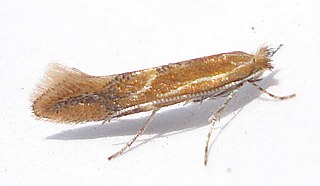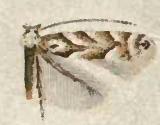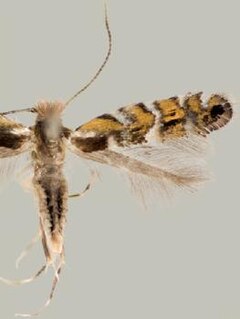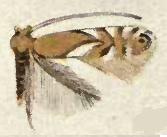
Gracillariidae is an important family of insects in the order Lepidoptera and the principal family of leaf miners that includes several economic, horticultural or recently invasive pest species such as the horse-chestnut leaf miner, Cameraria ohridella.

Macrosaccus robiniella is a moth of the family Gracillariidae.

The aspen leaf blotch miner moth is a moth of the family Gracillariidae. It is found in most of Europe. It is also present in Turkey and North America.

Phyllonorycter is a genus of moths in the family Gracillariidae.

The European oak leaf-miner or Zeller's midget is a moth of the family Gracillariidae. It is found in Europe south of the line running from Ireland, through Great Britain, Denmark to Ukraine. It is also found in Macaronesia. It is an introduced species in New Zealand and Australia.

Phyllonorycter salicifoliella is a moth of the family Gracillariidae. It is widespread across North America, from Mississippi to Ontario in the east and from southern California to northern British Columbia in the west.

Phyllonorycter scudderella is a moth of the family Gracillariidae. It is widespread in eastern North America from Ontario to Ohio and in western North America from south-eastern Alaska to Oregon.
Phyllonorycter pruinosella is a moth of the family Gracillariidae. It is known from Central Asia, Kazakhstan, Tajikistan, Turkmenistan and Uzbekistan.
Phyllonorycter pruinosella is a moth of the family Gracillariidae. It is known from Bengal and Bombay in what is now India and Bangladesh.
Phyllonorycter melacoronis is a moth of the family Gracillariidae. It is known from Japan (Kyushu), the Russian Far East and Korea.

Phyllonorycter albanotella is a moth of the family Gracillariidae. It is known from Ontario and Québec in Canada and Illinois, Kentucky, Ohio, Texas, Maine, Vermont and Connecticut in the United States.

Macrosaccus morrisella is a moth of the family Gracillariidae. In North America it is known from Manitoba, Ontario, and Quebec, south and west to Texas and Colorado.

Phyllonorycter alnicolella is a moth of the family Gracillariidae. It is known California and Maine in the United States and Ontario and Quebec in Canada.

Phyllonorycter aeriferella is a moth of the family Gracillariidae. It is known from Canada and the United States.
Cameraria macrocarpae is a moth of the family Gracillariidae. It is only known from Manitoba, Canada.
Phyllonorycter alaskana is a moth of the family Gracillariidae. It is known from Alaska in the United States, and Saskatchewan, Quebec, and Newfoundland in Canada.
Phyllonorycter achilleus is a moth of the family Gracillariidae. It is found in the Albertine Rift and the Kakamega Forest in western Kenya. The habitat consists of tropical rainforests where Guineo-Congolian flora intermixes with savannah plants at altitudes above 1,500 meters.
Phyllonorycter trochetellus is a moth of the family Gracillariidae. It is found in Mauritius.
Phyllonorycter tsavensis is a moth of the family Gracillariidae. It is found in Kenya and South Africa. The habitat consists of east African savannah.
Phyllonorycter mwatawalai is a moth of the family Gracillariidae. It is found in the Morogoro area of Tanzania. The habitat consists of a degraded savannah-like, natural biotope rich in low-growing woody Acacia trees and bushes and thick low dry herbarious vegetation. The area was surrounded by cultivated agricultural areas.


